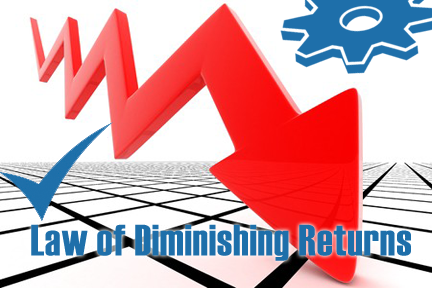 What do you know about the Law of Diminishing Returns, and when would it apply to your business?
What do you know about the Law of Diminishing Returns, and when would it apply to your business?
You are considering implementing a sustainable quality control system for your production processes, but something is eating at you!
Many owners tell me, “It would take too long to do a checklist, so I would expect diminishing returns on the time I’ve invested!”
So, you’re thinking that the time and money you save by NOT using a Quality Control Checklist is greater than the cost of errors incurred?
Well, let’s think about that!
Many have concluded that, “ERRORS are just the cost of doing business in our industry.” But, THAT’S the error!
Cost Objections and Diminishing Returns
Here’s a question for those of you who raise the cost objection. Have you ever measured and bench-marked the process of completing a checklist, versus the number and cost of errors incurred?
MY answer would be YES, to the same question! We HAVE measured the process of completing a checklist against the number and cost of errors incurred. As a matter of fact, we’ve done it for more than 15 years and for every key process. Furthermore, we would NEVER go back to the so-called ”normal way of doing business!” And NO diminishing returns!
The Proof’s in the Pudding
Over the years, our reports have PROVEN that using quality control systems does NOT cause diminishing returns on investment. Rather, the time and money saved is astounding; and certain other benefits have been priceless!
Something overlooked by skeptics of quality control systems is: they only consider the cost of a job having to be REWORKED. Moreover, they fail to include other nonconforming errors that happen all day, every day in most businesses.
For example:
Data input errors or lack of job specs. Meaning, one department has to call other departments seeking information to complete a job. That’s wasted time, at best; at worst, the job is spoiled due to lack of information. You get the same old lame excuses: “Nobody told me,” and/or “It wasn’t written on the Job Ticket.”
Other cost skeptics of quality control systems should consider the following, before concluding they will have diminishing returns:
- Mistakes are demoralizing not only to owners, but all employees.
- Job errors fail to instill confidence in customers and are detrimental to the growth of a business.
- In a bad economy, errors could mean the very survival of your company.
- Meeting time taken in addressing errors adds up in dollars.
- Peace of mind is forfeited.
In business, there are many more system-busting events that occur daily. Most of them are just swept under the rug, and the company continues to use the same unsystematic approach to fixing a problem—fallible human memory.
Quality Control Checklists | Time Involved
So, how long DOES it take to complete an average checklist?
Here is a question a potential client asked my son Paul, who was then our press room manager. “How long does it take your press operators to complete a Quality Control Checklist for the average printing job?”
“Oh, about 5 to 10 minutes,” Paul smiled at the surprised prospect. Paul explained that a checklist is setup in the same order you would normally check a job to catch any potential errors. Moreover, the more you get acquainted with the checklist, the more proficient you become. Paul added, “After a while, it’s kind of drilled into your head!”
I would concur with Paul’s answer. And I would add that the only way to drill quality control into the head of everyone on your team is, by doing it systematically!
Diminishing returns?
Thankfully, our company has yet to see diminishing returns, as we utilize sustainable quality control systems!
Did I mention? Great systems work!

Recent Comments